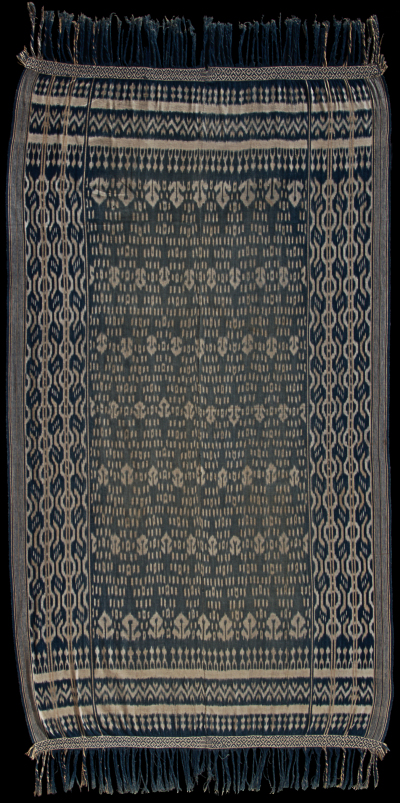| |
 
 | | | |
163 Sumba, West Sumba
Hanggi (blanket)  
| | Locale: | Kodi region. | | Period: | Late 19th - early 20th c. | | Yarn: | Cotton, hand-spun, medium, single weft (the mark of an apex Sumba weaving) | | Technique: | Warp ikat | | Panels: | 2 | | Size: | 125 x 228 cm (4' 1" x 7' 5") LW: 1.82 | | Weight: | 1050 g (37.0 oz), 368 g/m2 (1.21 oz/ft2) | | Design: | Hanggi ngoko, also called hanggi wolo remba. Field covered in characteristic python skin pattern, called rembe, and mamuli, earrings. The use of mamuli points to creation by a weaver of a noble lineage. Two lengthwise bands with diamond pattern called, mata kari, or buffalo eye. Endings with kiku rate, lizard tail motif. | | Comment: | Archetypical Kodi hanggi. Centre field is tinted a shade paler than the frame surrounding it. The cloth is either named hanggi ngoko, after the python, ngoko, or hanggi wolo remba, after wolo, ikat, and remba, netting. Yellow touches - ikated, not simply painted in after the weaving as if often done - strengthen the mimicry of the skin of Python reticulatus. Cloth has a robust feel and has a weight per m2 that is 75% higher than that of East Sumban hinggi. The sturdiness is much appreciated by the Kodinese as it reminds one of the toughness of python skin. | | Background: | Chapters on Sumba and West Sumba. | | Exhibited: | Museu do Oriente, Lisbon, 2014/15. | | Published: |
Woven Languages, 2014.
Ikat Textiles of the Indonesian Archipelago, 2018.
| | Sources: | Nearly identical to 19th C. hanggi in Khan Majlis, Indonesische Textilien, Fig. 420, similarly done in two shades of indigo, and to one in Australian National Museum, No. 1987.1817, depicted in Maxwell, Textiles of Southeast Asia, Fig. 88, though this example is slightly more faded, and probably older. Paler centre field noticeable also on hanggi in Brinkgreve and Fox, Living with Indonesian Art, Fig. 312. The opposite effect, a darker midfield and paler borders, is seen on a hanggi that used to be in the Nusantara Museum and at its collapse was donated to the Asian Civilisations Museum, Nr. S 1950-257. See also Gittinger, Splendid Symbols, Fig. 121; Völger and Von Welck, Indonesian Textiles/, Page 36, Photo 2; Metropolitan Museum of Art, No. 1999.47.160. In several of these the ochre yellow was clearly dabbed in after the weaving. From old Dutch collection. A very fine late 19th to early 20th c. example is depicted in Van Hout's Indonesian Textiles at the Tropenmuseum, Fig. 216, TM-556-95. | | |

©Peter ten Hoopen, 2025
All rights reserved.
|
|


